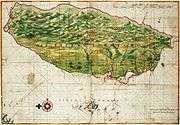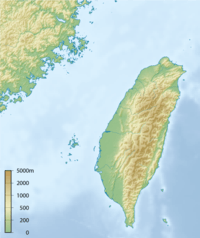Prehistory of Taiwan
Part of a series on the |
||||||||||||||||
|---|---|---|---|---|---|---|---|---|---|---|---|---|---|---|---|---|
| History of Taiwan | ||||||||||||||||
 | ||||||||||||||||
| Chronological | ||||||||||||||||
|
||||||||||||||||
| Topical | ||||||||||||||||
| Local | ||||||||||||||||
| Lists | ||||||||||||||||
| Taiwan portal | ||||||||||||||||
The prehistory of Taiwan, ending with the arrival of the Dutch East India Company in 1624, is known from archaeological finds throughout the island. The earliest evidence of human habitation dates back 20,000 to 30,000 years, when the Taiwan Strait was exposed by lower sea levels as a land bridge. Around 5,000 years ago farmers from the southeast Chinese coast settled on the island. These people are believed to have been speakers of Austronesian languages, which dispersed from Taiwan across the islands of the Pacific and Indian Oceans. The current Taiwanese aborigines are believed to be their descendants.
Geographical context

The island of Taiwan was formed approximately 4 to 5 million years ago on a complex convergent boundary between the continental Eurasian Plate and the oceanic Philippine Sea Plate. The boundary continues southwards in the Luzon Volcanic Arc, a chain of islands between Taiwan and the Philippine island of Luzon including Green Island and Orchid Island. From the northern part of the island the eastward continuation of the boundary is marked by the Ryukyu chain of volcanic islands.[1][2]
The island is separated from the coast of Fujian to the west by the Taiwan Strait, which is 130 km wide at its narrowest point. The most significant islands in the Strait are the Penghu islands 45 km from the southwest coast of Taiwan and 140 km from the mainland. Part of the continental shelf, the Strait is no more than 100 m deep, and has become a land bridge during glacial periods.[3]
Taiwan is a tilted fault block, with rugged longitudinal mountain ranges making up most of the eastern two-thirds of the island. They include more than two hundred peaks with elevations of over 3,000 m (9,843 ft). The western side of the island slopes down to fertile coastal plains. The island straddles the Tropic of Cancer, and has a humid subtropical climate.[4] The original vegetation ranged from tropical rainforest in the lowlands through temperate forests, boreal forest and alpine plants with increasing altitude.[5]
Late Paleolithic
During the Late Pleistocene glaciation, sea levels in the area were about 140 m lower than in the present day. As a result, the floor of the Taiwan Strait was exposed as a broad land bridge that was crossed by mainland fauna until the beginning of the Holocene 10,000 years ago.[3] A concentration of vertebrate fossils has been found in the channel between the Penghu Islands and Taiwan, including a partial jawbone designated Penghu 1, apparently belonging to a previously unknown species of genus Homo.[6]
In 1972, fragmentary fossils of anatomically modern humans were found at Chouqu and Gangzilin, in Zuozhen District, Tainan, in fossil beds exposed by erosion of the Cailiao River. Though some of the fragments are believed to be more recent, three cranial fragments and a molar tooth have been dated as between 20,000 and 30,000 years old. The find has been dubbed "Zuozhen Man". No associated artifacts have been found at the site.[7][8]
The oldest known artifacts are chipped-pebble tools of the Changbin culture (長濱文化), found at cave sites on the southeast coast of the island. The sites are dated 15,000 to 5,000 years ago, and similar to contemporary sites in Fujian. The primary site of Baxiandong (八仙洞), in Changbin, Taitung was first excavated in 1968. The same culture has been found at sites at Eluanbi on the southern tip of Taiwan, persisting until 5,000 years ago. The earliest layers feature large stone tools, and suggest a hunting and gathering lifestyle. Later layers have small stone tools of quartz, as well as tools made from bone, horn and shell, and suggest a shift to intensive fishing and shellfish collection.[9][10]
The distinct Wangxing culture (網形) was discovered in Miaoli County in northwest Taiwan in the 1980s. The assemblage consists of flake tools, becoming smaller and more standardized over time, and indicating a shift from gathering to hunting.[11]
Neolithic

Between 4000 and 3000 BC, the Dapenkeng culture (named after a site in Taipei county) abruptly appeared and quickly spread around the coast of the island, as well as Penghu. Dapenkeng sites are relatively homogeneous, characterized by pottery impressed with cord marks, pecked pebbles, highly polished stone adzes and thin points of greenish slate. The inhabitants cultivated rice and millet, and engaged in hunting, but were also heavily reliant on marine shells and fish. Most scholars believe this culture is not derived from the Changbinian, but was brought across the Strait by the ancestors of today's Taiwanese aborigines, speaking early Austronesian languages. Regarding the Dapenkeng, no ancestral culture on the mainland has been identified, but a number of shared features suggest ongoing contacts.[12][13] However, the overall neolithic-era of Taiwan strait is said, by scholars, to have been descended from mainland Chinese neolithic cultures, particularly the Hemudu and Majiabang cultures.[14]

In the following millennium, these technologies appeared on the northern coast of the Philippine island of Luzon (250 km south of Taiwan), where they, and presumably Austronesian languages, were adopted by the local population. This migration created a branch of Austronesian, the Malayo-Polynesian languages, which have since dispersed across a huge area from Madagascar to Hawaii, Easter Island and New Zealand. All other primary branches of Austronesian are found only on Taiwan, the urheimat of the family.[15][16][17]
The successors of the Dapenkeng culture throughout Taiwan were locally differentiated. The Fengpitou (鳳鼻頭) culture, characterized by fine red cord-marked pottery, was found in Penghu and the central and southern parts of the western side of the island, and a culture with similar pottery occupied the eastern coastal areas. These later differentiated into the Niumatou and Yingpu cultures in central Taiwan, the Niuchouzi (牛稠子) and Dahu cultures in the southwest, the Beinan Culture (see Beinan Cultural Park) in the southeast and the Qilin (麒麟) culture in the central east. The Yuanshan Culture (圓山) in the northeast does not appear to be closely related to these, featuring sectioned adzes, shouldered-stone adzes and pottery without cord impressions. Some scholars suggest that it represents another wave of immigration from the mainland, but no similar culture is known from there either.[18]
Iron Age
.jpg)
Artifacts of iron and other metals appeared on Taiwan around the beginning of the Common Era. At first these were trade goods, but by around 400 AD wrought iron was being produced locally using bloomeries, a technology possibly introduced from the Philippines. Distinct Iron Age cultures have been identified in different parts of the island: the Shihsanhang Culture (十三行文化) in the north, the Fanzaiyuan Culture (番仔園) in the northwest, the Daqiuyuan Culture (大邱園) in the hills of southwest Nantou County, the Kanding Culture in the central west, the Niaosung Culture in the southwest, the Guishan Culture (龜山) at the southern tip of the island, and the Jingpu Culture (靜浦) on the east coast. The earliest trade goods from China found on the island date from the Tang dynasty (618–907 AD).[19][20]
See also
References
- ↑ "The Geology of Taiwan". Department of Geology, National Taiwan Normal University.
- ↑ "Geology of Taiwan". Department of Geology, University of Arizona.
- 1 2 Chang, K.C. (1989). translated by W. Tsao, ed. by B. Gordon. "The Neolithic Taiwan Strait" (PDF). Kaogu 6: 541–550, 569.
- ↑ "Chapter 1: Geography" (PDF). The Republic of China Yearbook 2010. Government Information Office, Republic of China (Taiwan). Archived from the original on 6 June 2011.
- ↑ Tsukada, Matsuo (1966). "Late Pleistocene vegetation and climate of Taiwan (Formosa)". Proceedings of the National Academy of Sciences of the United States of America 55 (3): 543–548. doi:10.1073/pnas.55.3.543. PMC 224184. PMID 16591341.
- ↑ Chang, Chun-Hsiang; Kaifu, Yousuke; Takai, Masanaru; Kono, Reiko T.; Grün, Rainer; Matsu'ura, Shuji; Kinsley, Les; Lin, Liang-Kong (2015). "The first archaic Homo from Taiwan". Nature Communications 6. doi:10.1038/ncomms7037.
- ↑ Olsen, Sari; Miller-Antonio (1992). "The Palaeolithic in Southern China". Asian Perspectives 31 (2): 129–160.
- ↑ Liu, Yichang (2009). "Zuozhen Man". Encyclopedia of Taiwan.
- ↑ Jiao, Tianlong (2007). The Neolithic of southeast China: cultural transformation and regional interaction on the coast. Cambria Press. pp. 89–90. ISBN 978-1-934043-16-5.
- ↑ Liu, Yichang (2009). "Changbin Culture". Encyclopedia of Taiwan.
- ↑ Liu, Yichang (2009). "Wangxing Culture". Encyclopedia of Taiwan.
- ↑ Jiao (2007), pp. 91–94.
- ↑ Huang, Shihchiang (2009). "Tapenkeng Site". Encyclopedia of Taiwan.
- ↑ Jiao (2007). The Neolithic of Southeast China: Cultural Transformation and Regional Interaction on the Coast. p. 57.
- ↑ Blust, Robert (1999). "Subgrouping, circularity and extinction: some issues in Austronesian comparative linguistics". In E. Zeitoun; P.J.K Li. Selected papers from the Eighth International Conference on Austronesian Linguistics. Taipei: Academia Sinica. pp. 31–94.
- ↑ Diamond, Jared M. (2000). "Taiwan's gift to the world". Nature 403 (6771): 709–710. doi:10.1038/35001685. PMID 10693781. Archived from the original (PDF) on 21 June 2009.
- ↑ Mijares, Armand Salvador B. (2006). "The Early Austronesian Migration To Luzon: Perspectives From The Peñablanca Cave Sites". Bulletin of the Indo-Pacific Prehistory Association 26: 72–78. doi:10.7152/bippa.v26i0.11995.
- ↑ Jiao (2007), pp. 94–103.
- ↑ Tsang, Cheng-hwa (2000). "Recent advances in the Iron Age archaeology of Taiwan". Bulletin of the Indo-Pacific Prehistory Association 20: 153–158. doi:10.7152/bippa.v20i0.11751.
- ↑ Chen, Kwangtzuu (2009). "Iron Artifact". Encyclopedia of Taiwan.
| ||||||||||||||||||||||||||||||||||||||||||||||||||||||||||